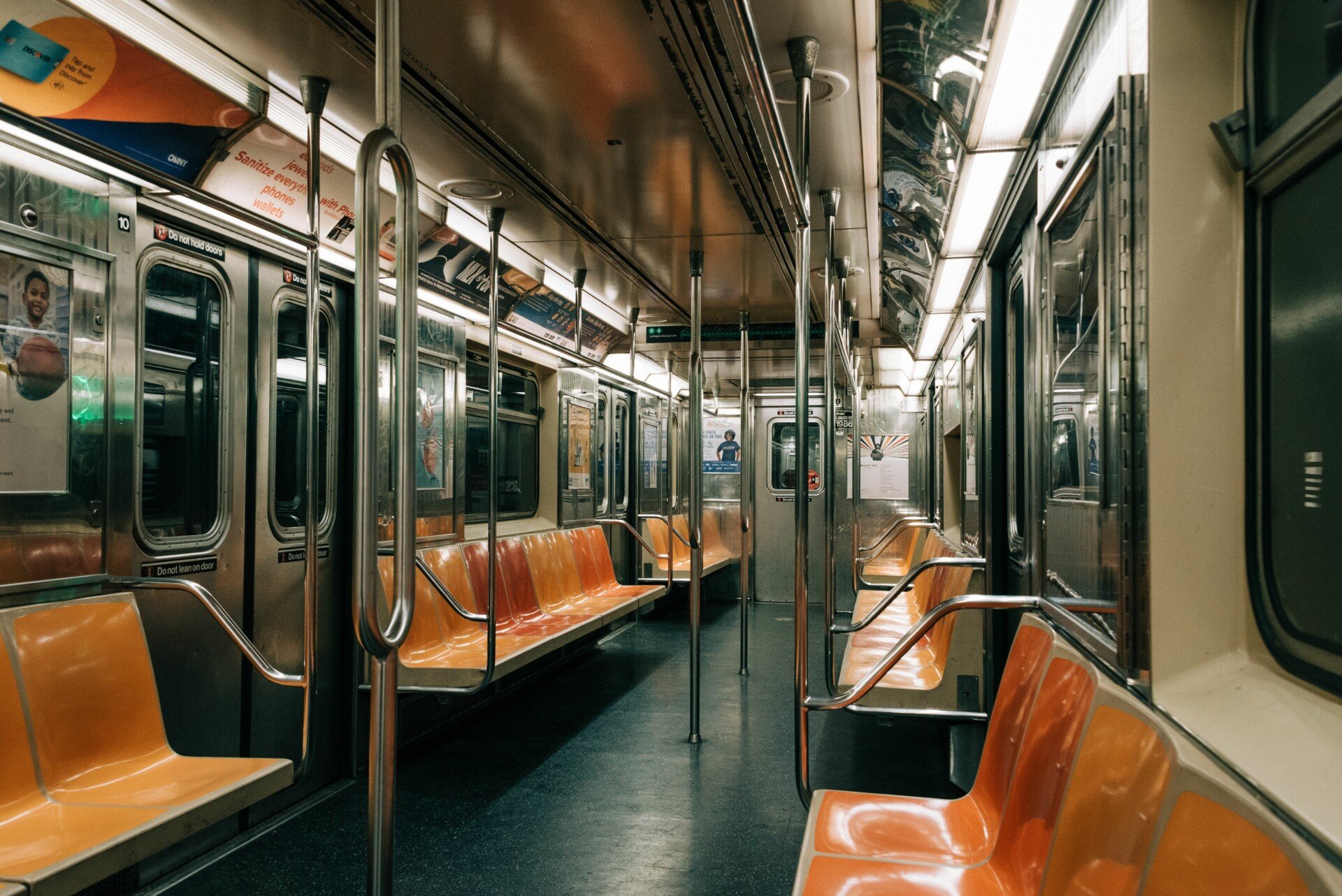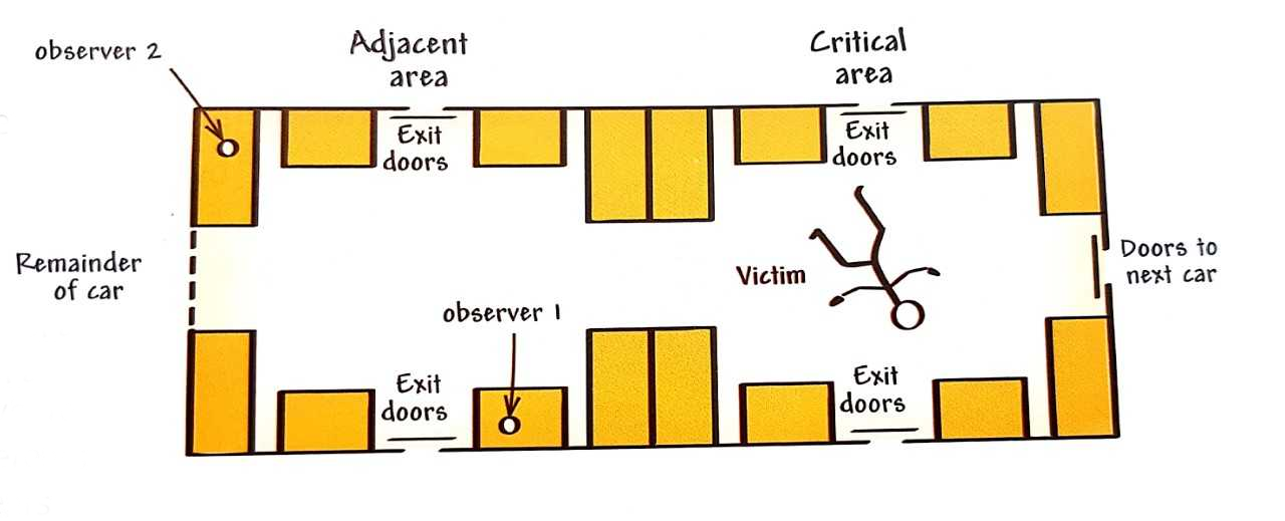On This Page:
Piliavin I. M., Rodin, J., & Piliavin, J. A. (1969). Good samaritanism: an underground phenomenon?. Journal of Personality and Social Psychology, 13 (4), 289.

Aim
This study was designed to investigate how a group of people would react if they saw a person who collapsed on a train.
Specifically, they wanted to investigate the following:
- Would an ill person get more help than a drunk person? (the type of victim)?
- Would people help others of the same race before helping those of different races?
- If a model person started helping the victim, would that encourage others to also help?
- Would the number of bystanders who saw the victim influence how much help was given?
Procedure
This study was a field experiment on a 7 ½ minute non-stop journey on a New York underground train, using various coaches along the train. Participants were passengers who were on board.
Using teams of 4 university students (male victim, male model, 2 female observers), a situation was created on the train to see how passengers would react.
A ‘victim’ staged an ‘emergency’ by collapsing (in the designated ‘critical area’).

After collapsing, the victim lay on his back on the floor. If not helped earlier in the journey by a participant or model, the model assisted the victim at the end of the journey.
Participants’ reactions were then watched by covert observers.
Participants
The victims were: males aged 26 -35; three white, one black; identically dressed in a US army-style jacket, old trousers, and no tie.
The ‘drunk’ smelled of alcohol and carried a spirits bottle wrapped in a brown paper bag (38 trials). The ‘ill ‘victim appeared sober and carried a black cane (65 trials).
The models were males aged 24 – 29, wore casual but not identical clothes, and helped by raising the victim to a sitting position and staying with him.
Independent Variables
- Type of victim (drunk or appearing ill and would hold a walking cane).
- Race of victim (black or white).
- Effect of the model (a researcher in disguise): stood near the victim and helped after about 70 seconds (critical area – early), stood in the same place but helped after 150 seconds (critical area – late), or stood further away and helped quickly or slowly (‘adjacent – early’ and ‘adjacent – late’), or no model at all. The trials were determined randomly.
- Size of the witnessing group (a naturally occurring independent variable). The sample consisted of the 4450 American passengers using that particular train, 45% of which were black and 55% white.
Dependent Variables
The dependent variables were covertly recorded (from behind newspapers) by two female observers seated in the adjacent area (during 103 victim trials):
- Number of bystanders
- Frequency of witness help
- Latency (time) to help
- Race of helper (45% black, 55% white)
- Sex of helper
- Number of helpers
- Movement out of the critical area
- Any verbal comments made by bystanders
There were 6-8 trials per day, on journeys in alternating directions, all the same victim type on any day.
Findings
- Models were rarely needed; the public usually helped quickly on their own.
- Apparently, ill victims are more likely to be helped than apparently drunk ones (62/65 trials compared to 19/38) and are more likely to be helped quickly.
- Males are more likely to help than females (60% of travelers were male, but 90% of first helpers were male).
- Race has little effect on helping, although a drunk victim is less likely to receive opposite-race help.
- The longer no help is offered, the less important modeling becomes and the more likely someone is to leave the area, and more so with drunk victims.
- Spontaneous comments were more common in the drunk condition.
Conclusion
One of the surprising findings in this study was that there was no diffusion of responsibility. The size of the group made no difference in how much help a victim received. Piliavin et al. offered several explanations for this:
- Passengers were trapped on the train and could not really leave the situation. On the street, the results may have been different.
- It was less effort for passengers to help. If they were sitting on the train anyway and were waiting for the next stop, they may as well help.
- Unlike the situation with Kitty Genovese, it was clear what the problem was for the bystanders who were sitting next to the victim.
Piliavin et al. (1969) put forward the cost–reward arousal model as a major alternative to the decision model and state it represents a ‘fine tuning’ of the earlier model.
In a similar fashion to Latané and Darley’s decision-helping model, it has two stages that occur before we either help or don’t help.
The first stage is physiological arousal. Arousal in response to the need or distress of others is an emotional response and provides the basic motivational construct of the model.
When we see someone in distress, we become physiologically aroused. The greater the arousal in emergencies, the more likely it is that a bystander will help since they wish to reduce it.
The cost–reward component stage involves evaluating the consequences of helping or not helping. Whether one helps or not depends on the outcome of weighing up both the costs and rewards of helping.
The costs of helping include effort, time, loss of resources, risk of harm, and negative emotional response. The rewards of helping include fame, gratitude from the victim and relatives, and self-satisfaction derived from the act of helping.
The costs of not helping include guilt, disapproval, damaged self-esteem, and also negative emotional responses. It is recognized that costs may be different for different people and may even differ from one occasion to another for the same person.
Helping is more likely: with ill than drunk victims; to be offered by males (as perceived costs are higher and social role reduces self-blame), and with same-race victims if they appear drunk (as perceived risk is higher, social role reduces self-blame and there may be same-race empathy and trust).
The longer an emergency continues, the less important the role of a model (because arousal has been reduced by other means) and the more likely people are to leave the area.
Critical Evaluation
The data gathered was both qualitative and quantitative. The quantitative data included the number and type of passengers who helped as well as the time taken to offer assistance.
The qualitative data came from the spontaneous comments made by the passengers. Both types of data are valuable in building up a full picture of what happened and why.
The quantitative data allowed for comparisons and statistical analysis, and the qualitative data provided some of the thoughts and feelings of the people involved, including perhaps providing explanations for why they did or did not help.
Reliability refers to the consistency of a measure and one aspect of reliability relevant to studies involving observations is how consistent different observers are when recording information on the same event, i.e., inter-rater reliability.
The reliability of this study was increased by the fact that there were two independent researchers observing and recording data. Hence they were able to measure inter-rater reliability.
Some people argue that the cost–reward arousal model is overly calculating. We do not weigh up the pros and cons of helping in as much detail as they suggest. Whilst arousal and helping are often only correlated, the model clearly sees the former as causing the latter.
According to Dovidio et al. (1991), evidence indicates that emotional reactions to other people’s distress play an important role in motivating helping. The model proposes that bystanders will choose the response that most rapidly and completely reduces the arousal, incurring as few costs as possible.
Therefore the emotional component provides the motivation to do something, whilst the cognitive component determines what the most effective response will be.
Piliavin et al.’s original model was subsequently elaborated to take account of the role played by other factors.
Many of the variables interact and contribute to how aroused the bystander is and the perceived costs and rewards for direct intervention.
A strength of the sample is that it is fairly big and, therefore, would be representative of people who used the subway in NYC; e.g., 4450 participants were estimated to have been involved.
One ethical issue is the lack of informed consent within this study – participants were not aware that they were involved in an experiment.
Another ethical issue in Piliavin et al.’s study is that the participants could not be debriefed at the end of the experiment.
Thus, not allowing the participants to know that they were involved in an experiment and that all incidences that occurred on that Subway journey were controlled.
References
Dovidio, J. F., Piliavin, J. A., Gaertner, S. L., Schroeder, D. A., & Clark III, R. D. (1991). The arousal: Cost-reward model and the process of intervention: A review of the evidence.
Piliavin, I. M., Rodin, J., & Piliavin, J. A. (1969). Good samaritanism: an underground phenomenon? Journal of Personality and Social Psychology, 13(4), 289.

